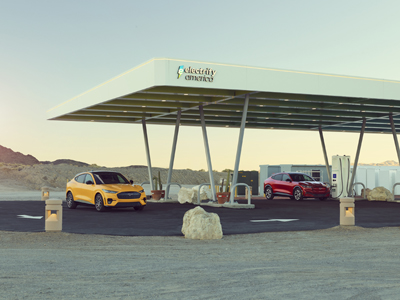With seven states taking steps to require all new passenger vehicles sold to be zero emissions by 2035, experts are looking closely at the cost and environmental impact of these cars, including their production, operation and disposal. The states include California, Massachusetts, Maryland, New Jersey, New York, Oregon and Washington.
Dr. Robert Freerks, a consultant in fuels and lubricants at RLF Enterprises, shared information during a webinar hosted by the Specialty Equipment Market Association (SEMA) about whether the current infrastructure can support the widespread adoption of electric vehicles (EVs) to meet the goal of net zero emissions by 2050.
“Everyone thinks of them as zero-emissions vehicles but… they have emissions from all of the energy that went into producing them, as well as the energy required to make the electricity that drives them,” said Freerks, who has a Ph.D. in synthetic organic chemistry and a history of studying fuels and lubricants to understand energy issues.
One of the main challenges, according to Freerks, is the electric grid is not set up to deliver the huge amounts of power needed to keep an EV fleet moving.
“It’s going to be an incredibly expensive increase in our electrical demand and supply to make an electric vehicle market work,” he said. “We’re not going to get there. There’s no way we are going to have zero emissions by 2050 in any realistic sense.”

However, Electrify America points to studies showing grid generation capacity is more than capable of meeting charging needs even with high EV market growth.
“There are innovative ways to support the electricity needs of the fast-growing EV industry---particularly through battery energy storage,” said Robert Barossa, president and CEO of Electrify America.
As of 2022, Electrify America installed on-site, behind-the-meter battery energy storage systems (BESS) at more than 160 DC-fast charging stations around the country, including more than 90 installations in California.
“These systems store power when electricity costs are low and supplement power during high points of consumption, helping to stabilize costs and help maximize renewable energy use,” explained Barrosa.
Raw Materials Used to Produce EVs
Compared to an internal combustion engine (ICE) vehicle, Freerks said the raw materials needed to produce an EV are massive. While conventional cars use aluminum and iron as the primary source of their metals, EVs and their batteries rely on huge amounts of precious metals, such as copper and lithium.
“Copper is becoming in short supply and an EV has four times as much copper in it than an ICE vehicle,” he noted. “We are going to be short of a lot of raw materials that are going to make these EVs producible.”
Although there is a relatively low volume of lithium in an EV, Freerks said the price has quadrupled over the last several months. The annual average U.S. lithium carbonate price in 2021 was more than double the previous year, according to research from a U.S. Geological Survey, Mineral Commodity Summaries, in January 2022.
“Metal costs are going up quickly and are going to increase the cost of batteries, and therefore, the vehicles that use them,” he said.
This is partly due to the reliance on these raw materials from other countries, such as Russia and China.
“We’re going to end up relying on other countries… for a lot of the raw materials that make our transportation system work,” observed Freerks.
Along with the seven states, Great Britain aims to go all-electric by 2035.
“If they did, they would need 7.2 million battery EVs, or about 1% of the total vehicle fleet,” said Freerks. “I can’t see that happening. It would take almost all the raw materials in the world today to make one country all electric.”
Environmental Impact of EVs and Battery Production
In addition to raw material shortages and rising costs, Freerks said EV lithium-ion batteries have a massive environmental impact.
Production of the metals used in EV batteries requires mining 90,000 pounds of ore and moving 200,000 to 1.5 million pounds of earth, he calculates, which is an average of 50,000 pounds earth moved per battery.
“To make a ton battery, which goes into a vehicle like a Tesla, you need to move between 700,000 and 1.3 million tons of earth,” he explained. “That is an incredible impact on the environment to move that much earth to get the raw materials to make a single battery.”
When evaluating the environmental impact of an EV, Freerks stressed the importance of taking a life cycle assessment, which includes looking at all energy sources and greenhouse gas emissions associated with the total lifecycle of a product.
In California, for example, Freerks said, EVs have about a 40% reduction in greenhouse gas emissions compared to an ICE vehicle. However, if that same car is operating in a state like Colorado, where there is a lot of coal used to make electricity, greenhouse gases are higher than a gasoline vehicle.
“There are always greenhouse gas emissions for any energy source that is produced,” explained Freerks. Even a wind farm or solar field, for example, emits greenhouse gas emissions.
“There are ways that we can get that down to zero or even negative, but it takes a lot of effort and essentially a lot of costs to get there,” he added.
Evaluating Alternative Sources of Energy
There are a number of renewable fuels currently being used and/or evaluated. These include ethanol made from corn and cereal grains, biodiesel from fats, oils and greases, renewable diesel, and algae. In addition, Freerks said alcohol, which can be converted to hydrocarbons, is expected to become more readily available due to decreasing gasoline consumption.

Freerks said the quality and performance of these alternative sources of energy significantly depend on the process and technology used.
He foresees the potential use of waste wood products and municipal solid waste to produce renewable fuels in the future and estimates it could equate to about 4 million barrels a day of fuel---or 20% of U.S. consumption.
“In terms of greenhouse gas emissions, we could make some pretty impressive impacts on CO2 reduction by using waste and then carbon capture and storage to further reduce carbon intensities,” he said.
Freerks believes a more stable energy source, such as nuclear, will be needed to replace some of the renewable energy. “Nuclear is a non-carbon-emitting source of energy that I think will provide us a lot of our energy in the future,” he explained.
However, even with these renewable energy options, Freerks said it won’t be enough to displace what is currently used in terms of crude oil.
The U.S. is the top producer of crude oil and natural gas in the world and will still be the major source of energy, he said, citing research from the U.S. Energy Information Administration (EIA).
“We consume about 20 million barrels a day of oil and can only make 100,000 barrels a day of biodiesel, so it’s never going to replace crude oil,” noted Freerks. “Producing fuels from food is not a viable option… We’re never going to get the feedstocks needed to totally replace crude oil with renewable fuels from fats, oils and greases.”
However, he said, there are ways to reduce greenhouse gas emissions and keep crude oil sourcing.
If the goal is to get to net zero, Freerks said vast increases in wind and solar energy will be needed while being backed up by fossil fuel energy. He estimates 3% of U.S. total energy consumption currently comes from wind and solar. To get to net zero by 2050, Freerks said, we are going to have to grossly increase that production.
“Only in certain locations, such as California, does an EV make sense,” according to Freerks. “The reason is because California gets a lot of its power from the Pacific Northwest hydroelectric dams and also has a lot of wind and solar.”
Additional EV Battery Considerations
With the expected growth of EVs in market share, Freerks predicts industry experts will continue to research and address the outstanding issues associated with lithium-ion batteries.
Although reports show battery costs are declining and expected to dip below $100 per cell, and advances in battery types and chemistries occur almost daily, Freerks contends the opposite.
He forecasts battery costs to continue to rise and be a significant cost of EVs moving forward due to the major shortage and cost for materials.
At the same time, battery risks remain high. As a result, vehicle owners and manufacturers will have to contend with EV batteries catching on fire if they aren’t handled properly. According to Battery University, they must be put out with a foam extinguisher, CO2, ABC dry chemical, powder graphite, copper powder or sodium carbonate. If the fire can’t be extinguished, they need to burn in a controlled way.
“There have been no major advances in design and material content to reduce metal content in the last few years,” said Freerks. “They are reaching the limit of what the chemistry of the battery can do.”
There are also outstanding questions regarding battery recycling and disposal.
“The number of spent batteries that are going to be generated by these EVs is skyrocketing now and it’s going to get worse in 2040 if mandates for EVs become more prevalent,” said Freerks.
Infrastructure changes will need to be made to accommodate EV growth. This includes the availability of convenient charging stations. Electrify America is taking steps to meet this challenge by investing more than $2 billion in EV charging infrastructure and education.
Barossa said Electrify America and Electrify Canada expect to double the number of chargers on the combined networks by 2026. He estimates approximately 90% of Californians live within 15 miles of an Electrify America fast charger, with 96% located within 25 miles.
“When evaluating alternative energy sources and uses, one has to consider all aspects of the problem, not just the localized issues such as direct emissions from a vehicle,” noted Freerks. “EVs may not directly emit greenhouse gas emissions as they are battery-powered, but all the other aspects of battery electric vehicles have associated emissions that are a part of the global environment even if not directly part of the local environment."
Although there are challenges to address while transitioning to EVs, many organizations are proponents of moving forward with the widespread adoption to protect air quality and deal with the impacts of climate change.
“Transportation is a major driver of harmful emissions entering the air,” said Barossa. He estimates that before the COVID-19 pandemic, up to 55% of total nitrogen oxide emissions were caused by the transportation sector.
“Research shows that an EV is typically responsible for lower levels of greenhouse gases (GHGs) than the average new gasoline car,” he said. “Through more widespread EV adoption, a more sustainable world with cleaner air is possible.”
To watch the SEMA webinar, visit the website.















Stacey Phillips Ronak